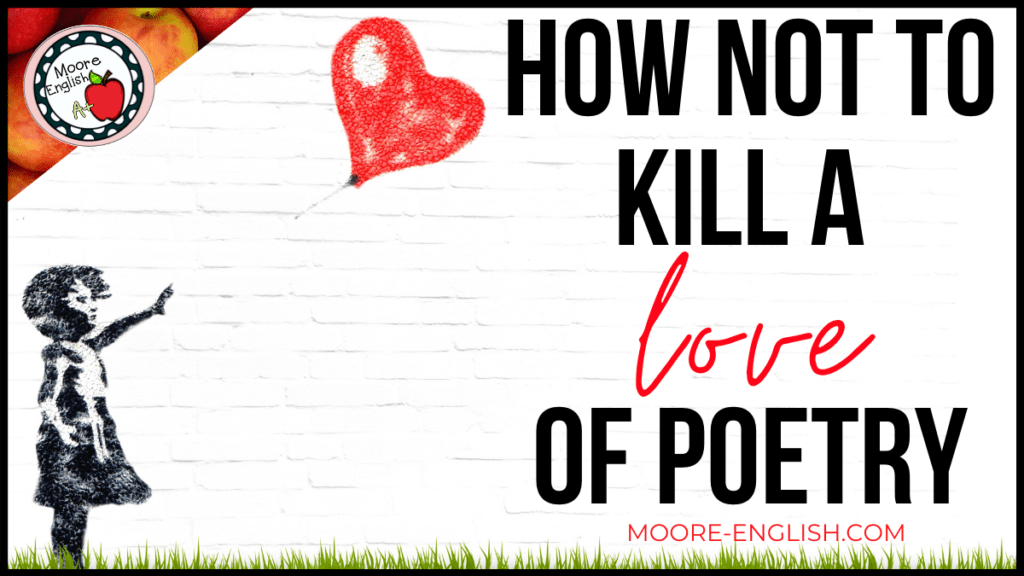I was in college before I loved poetry.
Prior to that, I hated poetry because it was a language no one taught me to speak. Poetry was an incomprehensible collection of sounds and images and rhymes. Clearly, poets had some kind of cypher key they only gave to teachers. And my mom bought off-brand cereal, so I didn’t find a matching cypher key at the bottom of the box.
So what happened in college? What turned me around on poetry and helped me learn to love poetry?
Someone taught me how to read poetry. That’s it. Once I knew how to read poetry, I couldn’t help but fall in love. Once I spoke the language, the poetry spoke for itself. I didn’t need anymore convincing. And that’s how I convince my students that it’s okay to love poetry.
This post this post may contain affiliate links. Please read the Terms of Use.
Make Poetry Knowable
Poetry is a struggle for students who don’t know how to speak the language. For this reason, teachers have to help students understand the language.
First, that means starting with these four simple steps and these tools for pre-reading.
Also, use poetry that has strong text features. A lot of poetry is based on a poem’s historical context or movement. For example, understanding “The Second Coming” without understanding its allusions is frustrating. For this reason, it’s important to choose poems that are made accessible by the use of footnotes, background notes, and/or images.
Finally, start with what you know and where you are comfortable. Not every teacher loves poetry. And your students can tell when poetry is not your thing. For this reason, start with a poem or poet you do love. Even if you’re not a poetry expert, your joy and excitement about a text will help students engage.
Provide Scaffolding for a Love of Poetry
In my state, the end-of-year assessment often features a dense piece of classical poetry. I have to admit that while I love “Thanatopsis,” it’s not the most accessible piece of literature. Even though my state assessment emphasizes this kind of old white-man poetry, teaching this kind of dense poetry exclusively is a great way to convince students not to love poetry.
Instead, scaffold upward to the difficult pieces of poetry. Start with less intimidating and more engaging pieces. Here are some options for a poetry “starter pack”:
- Start with living poets like Maggie Smith or Brenda Shaughnessy
- Try free verse from Walt Whitman or David Tomas Martinez
- Include blank verse text from Emily Dickinson
- Move toward predictable poetic forms like Shakespearean sonnets
Avoid Jargon
Using too much jargon can be a way to prevent love of poetry. On one hand, teachers want to help students engage with poetry in a meaningful way. On the other hand, do students really need to know every poetic term in order to appreciate poetry?
Studying poetry comes with a lot of dense vocabulary. If you want to, you can really lean into some obscure vocabulary. However, chances are, students only need a handful of terms:
- Stanza and line
- Turn and meter
- Rhyme and rhythm
Once students figure out how to read poetry, they may begin to experience a love of poetry. Once that happens, dig into some of the more obscure terms like “dactyl” or “tetrameter.”
Similarly, students do not need to know every type of poetry in order to appreciate poetry. Cataloguing poetry types (acrostic, blackout, found poems) isn’t loving poetry. Finally, avoid assessing poetic vocabulary unless your curriculum explicitly calls for students to know every term related to the study of poetry. Assessment should not be a killer of love of poetry.
Invite Creativity and Diversity
Poetry has great advantages, one of which is its ability to invite myriad interpretations. Rather than presenting each poem as having one clear interpretation, be open to creative interpretations. So long as students can support their interpretations with evidence form the text, encourage them to be creative in their readings.
Another advantage of poetry is its ability to speak to diverse readers. Poetry can be a place where students recognize themselves and their interests and concerns. So provide students with a diverse cast of poets and perspectives. Here are some options for incorporating diversity into your class reading of poetry:
- “Respiration” by Jamaal May
- The Poetry of Langston Hughes
- “Making a Fist” by Naomi Shihab Nye
- “Tula [‘Books are door-shaped ’]” by Margarita Engle
- “For the Consideration of Poets” by Haki R. Madhubuti
- “We Lived Happily During the War” by Ilya Kaminsky
Building Love of Poetry
Ultimately, a love of poetry comes from an understanding of poetry. Being able to “speak” to poetry comes from being able to know it. A love of poetry comes from intentional practice, from knowing poetry beyond the exclusively academic, and from a place of creativity and diversity. With these tools and ideas, your students will have a chance to learn to love poetry early.











